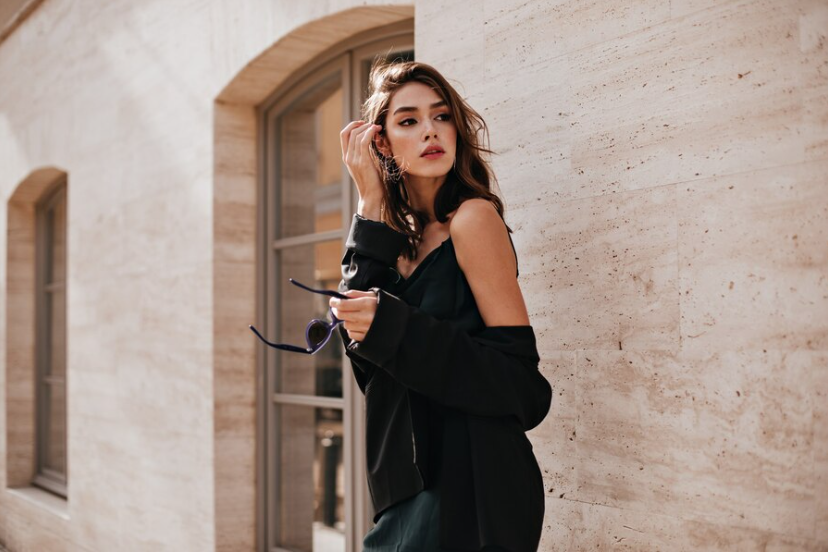It’s the one essential item that every woman’s closet must have. When you have nothing to wear to an impromptu occasion, it’s the one that saves the day. You are aware of this one. The one you can dress up or down for any event.
It is timeless, understated, and sophisticated all at once. Yes, the tiny black Dress is the article of discussion!
Traditional. Easy and Sophisticated
The little black dress, or LBD as some people lovingly refer to it, was initially introduced in the late 1920s and gained popularity in the 1930s. It is a timeless item of apparel for women. You may be creative with how you accessorize this dress—you can add pearls, jewels, a pendant, vibrant colors—you name it! This closet staple looks well with any accessories, whether it’s for a date night out in town or cocktails on a girl’s night.
However, your timeless little black dress is more than just an item of clothing—it has a backstory. It’s a statement rather than merely a piece of apparel.
The History of the Traditional LBD
What designer of clothing comes to mind when you envision “the little black dress”?
Before the 1920s, black clothing was only appropriate at times of grief. The fashion industry at the time was committed to enormous hats and tight corsets. When Coco Chanel featured a short, basic black dress on the front of Vogue magazine in 1926, everything changed.
Little black dresses swiftly rose to prominence as among the most significant and influential clothing items. Despite the Great Depression of the 1930s, its affordability and simplicity kept it popular.
Chanel broke free from the excess, tight corsets, and constricting clothing that had dominated the previous era of fashion with an elegant yet practical dress with straight lines.
The Little Black Dress Is Released in a Wide Format
After Audrey Hepburn, an actress, donned a little black dress with pearls in the 1961 film “Breakfast at Tiffany’s,” the outfit gained popularity. Since then, a wide range of accessories have been worn with it for any occasion.
The Dress in Black Little
Karl Lagerfeld once said, “One is never overdressed or underdressed with a little black dress.” Few fashion trends last eternally and establish themselves as mainstays among trendsetters. The runway shows of designers frequently feature these timeless looks that never go out of style. One such item that has withstood numerous fashion fads and trends is the Little Black Dress (LBD), which has evolved into a classic statement piece that every woman should have in her closet.
Women have been wearing LBDs for years because they are so versatile and can be worn for both formal and informal occasions. If you wear a stylish and sophisticated LBD to practically all evening events, you can never go wrong and effortlessly avoid fashion faux pas. Since the LBD’s founding, its organization and style have seen substantial development. Still, it has all of the same timeless appeal, adaptability, and affordability.
Traditionally, women in mourning had to adhere to stringent regulations and wear only black garments for around a year. Black was also connected with grief. Many women dressed in black and entered the workforce to support their families during the Great Depression and World War II. As a result, most women started wearing basic black dresses as their go-to outfit for power events.
Coco Chanel created the first-ever LBD in the 1920s. When Chanel’s black dress appeared on the 1926 Vogue cover, it instantly became popular with ladies. The magazine compared it to the success of Ford’s reasonably priced Model T car, referring to it as Coco’s “Ford.” The dress had a drop waist, and basic cuts, and was frequently paired with pearl accessories. Women from all social classes may use it due to its widespread appeal. By the end of the 1920s, black had transcended its original connotation of mourning to become the norm and the height of mystery and elegance, ruling the world of women’s high fashion.
Jazz was popular in the 1930s, and LBDs had sequins, flappers, and free-form patterns. The war made the LBD more conservative in the 1940s. Women invested in a timeless LBD and customized its style with various accessories, making it the ideal outfit for almost any setting.
In the 1950s, Hollywood began to show an increasing fondness and interest in the LBD. The tiny black dress had evolved into a striking and daring emblem by now, ideal for amplifying the glitz on the big screen. This decade saw Christian Dior’s creations, particularly LBD versions, dominate the fashion landscape. The collection broke from the more conservative style that ladies wore during the war by featuring wider skirt forms and nipped waists. The LBD of the 1950s pushed the boundaries of length to appeal to a younger, more open-minded clientele.
The LBD gained popularity in the 1960s in two distinct forms. The younger generation adopted short hemlines, a high slit, and net trimming, while the older women kept to the more traditional style and look of LBDs. But Audrey Hepburn’s iconic Givenchy LBD from the film Breakfast at Tiffany’s was the game-changer. In no time at all, the dress became the new definition of cool. Additionally, embellishments started to be utilized frequently as an element in 1960s LBDs.
The LBDs’ appearance has only grown more striking and daring over time. Punk rock ruled the 1970s, and attitude also became increasingly important in fashion, which greatly influenced LBD variations. Designs for the ’70s modern lady were molded using safety pins, fishnet stockings, and torn cuts. The pinnacle of the 1980s LBDs was the widely adopted peplum trend that is still in style today. The little black dresses underwent a fresh differentiation as the necklines became narrower and the shoulders grew wider.
The 90s aesthetic of the LBDs resembled a cross between grunge and a return to basics. The body-hugging, short dresses were typically worn with sandals or leather boots. The bandeau and baby doll dress styles were popular LBDs in the 2000s fashion industry. More velvet materials and laces are used in the most recent version of the little black dress. Its shape is more body-sculpting, and it has more intricate cuts.
The Little Black Dress is still a classic, despite many fads having come and gone. An LBD and a jacket go well together for a formal or daytime look, and the same LBD may be dressed up for an evening drink with shoes and accessories. A classic black lacy dress that can be worn to several events is a wardrobe staple for any fashionista. Because of this, the LBD is a timeless piece to invest in and a style that is still in vogue today.

